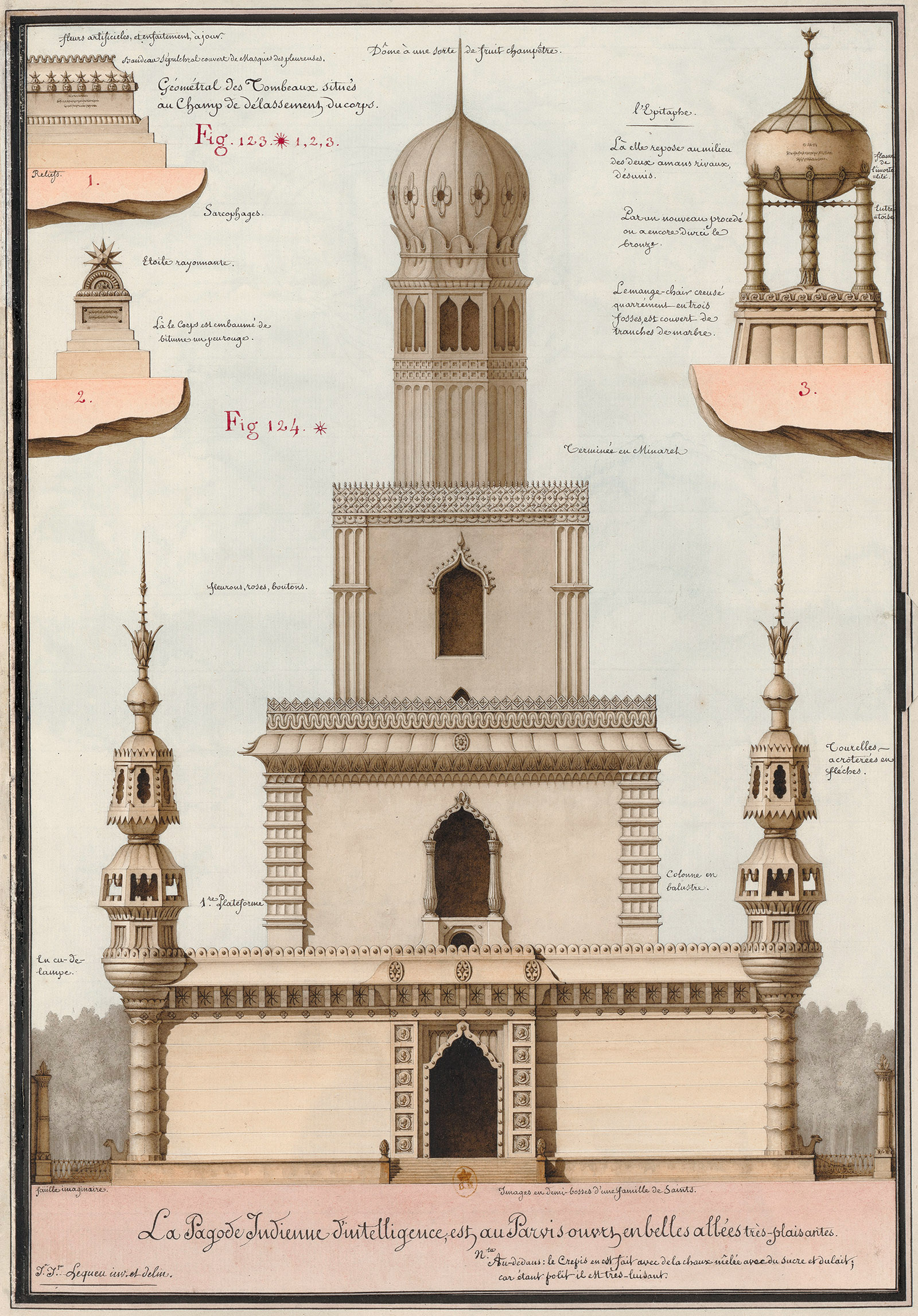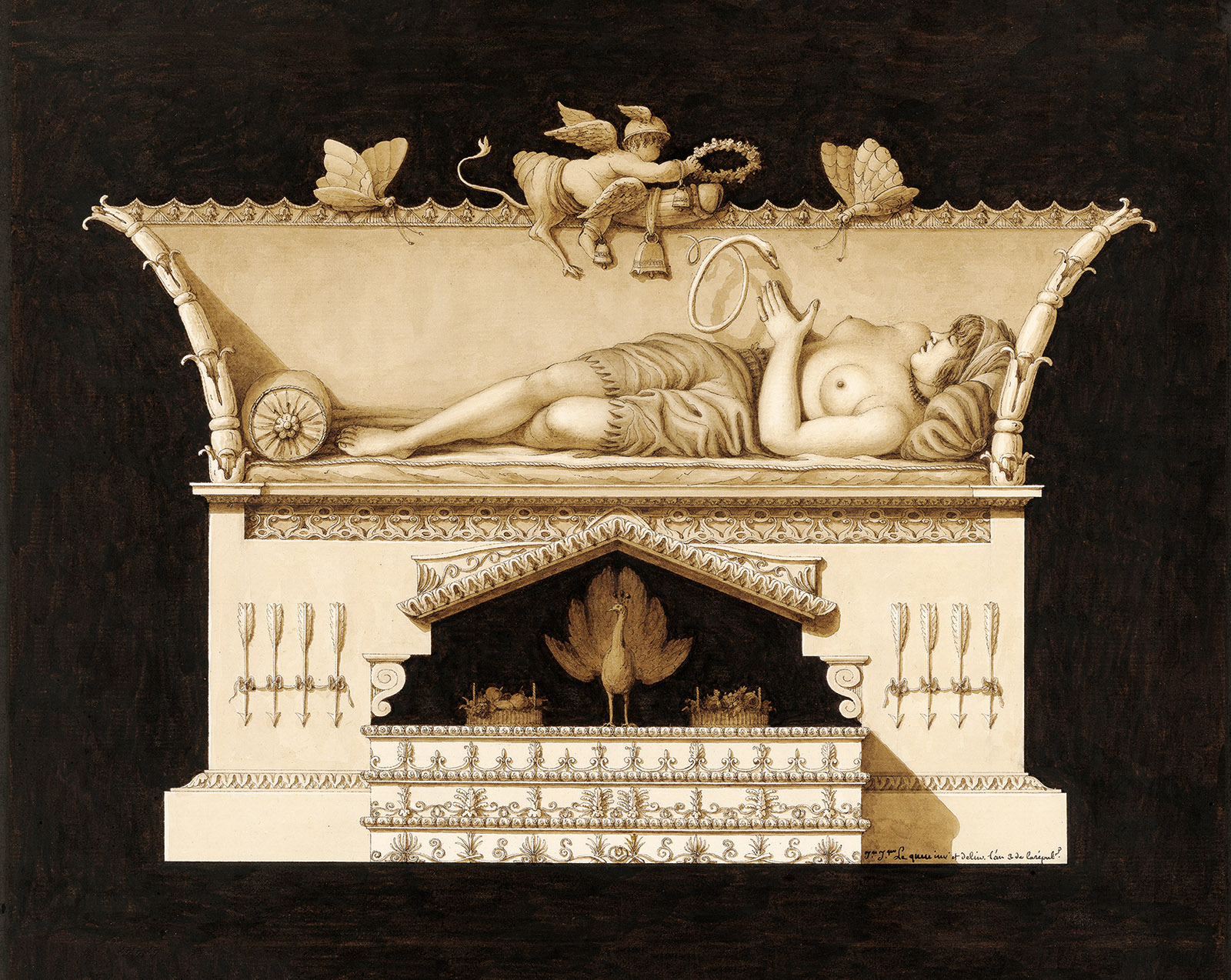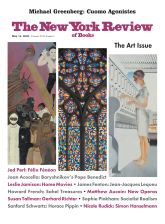Boullée, Ledoux, Lequeu—three French architects of the late eighteenth century, dreamers, revolutionaries, megalomaniacs at times, for whom the revolution came as a professional and near-personal catastrophe. Although they worked in the age of neoclassicism, and although interest in their productions was revived in the last century at the same time as interest in neoclassicism grew, they themselves were not, properly speaking, neoclassicists. They were innovative. They loved solid geometry—simple shapes, unadorned surfaces, unfamiliar idioms. Conical lighthouses, for instance. But then too they could be practical in a flashy way, inserting the equivalent of underground parking garages in their villas, where the horses and carriages of guests might await the after-dinner call. They liked the idea of buildings whose bases were half concealed in the earth, as those of many classical structures would have been in that period. And they shared the taste, common throughout the Europe of the day, for playful garden pavilions in exotic styles—twig houses, or that famous work of François Barbier, still standing in the garden of the Désert of Retz a few miles west of Paris: a house in the form of a massive broken column.
Above all they would have liked to build spherical structures, representing equality in all parts. Étienne-Louis Boullée (1728–1799) is celebrated for designing a spherical building that looks at first sight like a nuclear reactor but turns out to be a cenotaph for Sir Isaac Newton. He also made designs for a national library of quite astonishing size, with a single tunnel-vaulted and top-lit room where the library users and staff, on close inspection, are revealed as robed figures from Raphael’s School of Athens. Size mattered to Boullée, and his plan for the “restoration” of Versailles was to make it much, much bigger, as if size had been the problem all along. He believed that his buildings should be in some sense like poems, dreamlike exercises in an elevated style. In a way, the drawing itself, rather than the intended building, was the work of art.
It was remarked of this period of architectural drawings that architects strained to capture the attention of the public; that, in direct proportion to the proliferation of drawings, there was a diminution of opportunities for the architect to practice his skills. In the old days, it was complained, most architectural drawings were made with simple strokes of the pen, with hatching or wash illustrating the measurable proportions of the building. With the new style of drawing, a prison had to look like a prison—menacing and overwhelming. A morgue should look terrifying, full of gloomy shadows. The way a building sat in the landscape, the way it stretched out under the sky, the impression it made from a great distance—all these were now considerations for the draftsman.
Claude-Nicolas Ledoux (1736–1806) is the one member of this trio to have left something substantial in the way of built work, although many of his houses were demolished at a time when his reputation was at its nadir. He had given some reason to be disliked. His barrières—tollgates commanding all the entrances to Paris—were a part of a detested tax regime. (One of them, the Barrière d’Enfer, acquired an accidental fame: it forms the setting for act 3 of La Bohème.) His clients included Madame du Barry, for whom he built a pavilion and an enormous stable block.
Ledoux was a pioneer of the reform of theatrical design and built the theater at Besançon, in connection with which he made an engraving of extraordinary interest, in which the interior of the theater is seen reflected in a huge human eye. As Anthony Vidler puts it in Claude-Nicolas Ledoux: Architecture and Social Reform at the End of the Ancien Régime (1990):
The “frame” of vision, formed by the eyelid as it cuts the pupil across the top, follows a contour exactly that of the proscenium, rounded at the sides, flattened at the top. Seen in this way, the engraving suggests a view through a transparent pupil, to the empty auditorium as well as its reflection. The eye, as Ledoux pointed out, was indeed the “first frame” through which the world was seen, and remains the frame of vision for each individual member of the audience.
Jean-Jacques Lequeu (1757–1826) had some explaining to do when the revolution broke out. So he designed a “Parisis Gate” or “Arch of the People” on top of which a gigantic Hercules reclines, holding in one hand Liberty with her Phrygian cap and, in the other, the great club with which he crushes all the symbols of oppression that the architect could think of:
royal crowns and capes, a diadem, royal scepter, golden staff, swords of the spiritual and the temporal, the golden dove containing sacred ointment, golden spoon and spurs, a coat of mail, the Ring, baldric, an oriflamme, royal banner and a Banner, foreign claims in France, and other symbols of royal authority.
In case anyone didn’t get the point, the feet of Hercules are shown crushing other royal emblems, while on his head, a cock “stretches its neck, flaps its wings, and sings [expressing] the daring, the vigilance, and the pride of the ancient Gauls and is the true symbol of the French nation.” All these notes in the artist’s hand may seem fussy to the point of neurosis, but it was 1794, Year 2 of the republic. Lequeu was under arrest and needed to prove his republican credentials. He showed the drawing to the Committee for Public Safety, and it worked like a charm. The committee decided that the “Arch of the People” should be exhibited. Later Lequeu wrote on the verso of this preposterous sheet, “Drawing to save me from the guillotine—all for my native land.” He had judged the preposterousness perfectly.
Advertisement
The crazy gate was never built. None of Lequeu’s work was still standing at the time of his death, and there seems to have been precious little built work anyway. But here is a curious distinction. It is said that in this period of the eighteenth century, when a house was finished, the plans were often thrown away, as being of no further interest. But if the building in question had not been built or finished, then the drawings might indeed retain some significance, especially in the eyes of their maker. Lequeu valued his drawings and tried late in life to sell them. Meeting with no interest at all, he decided to give them to the National Library of France. And here things could so easily have gone wrong. Lequeu was largely unknown as an architect, having spent much of his working life as a cartographer for the Ministry of the Interior. And besides, a significant number of the drawings were highly obscene: studies of female and male genitalia, a masturbating woman drawn from life, a penis deformed by paraphimosis—all subjects that, for Lequeu, had a potential architectural application. The ideal curve for a balustrade, for instance, might be sought in the outline of a woman’s thighs.
The National Library rose perfectly to the occasion. It already had a section for storing obscene material, called Enfer, or Hell. For the rest, whether out of genuine enthusiasm or because of some now-invisible link of influence (such as Freemasonry), it seems to have happily preserved everything. Nobody appears to have paid any further attention to Lequeu until around 1952, when he was included with Boullée and Ledoux in Emil Kaufmann’s Three Revolutionary Architects. In America, a traveling exhibition called “Visionary Architects” brought the three together again in 1967–1968, very much to the disadvantage of Lequeu. As Dominique de Ménil put it in the foreword to the catalog of that show:
Lequeu’s universe is crowded with details and marginalia, but it is nonetheless empty; alcoves are deserted; temples have no devotees; roads no traffic. The question becomes inevitable: Was Lequeu ever addressing anyone but himself?
Meanwhile J.-C. Lemagny, in the same catalog, wonders whether “a solitary eccentric who was among the forerunners of the ‘bad taste’ of the late nineteenth century, should not be counted in this group.”
Clearly nobody had yet contrived to put Lequeu’s surprising character together in all its many aspects. If they had examined the erotic work, it can only have been to turn away from it in embarrassment and distaste. He seems to have lacked a champion, some artist perhaps, some Surrealist delighted to be scandalized by this singular take on sexuality (someone like Georges Bataille). The exhibition at the Morgan Library, “Jean-Jacques Lequeu: Visionary Architect,” currently alas shuttered, is based on a French show that opened in 2018. It is a little sparing on the erotica, and it is served only by the catalog of the French show, so the situation is not ideal. But it offers the best opportunity yet to begin to form an opinion of this singular artist.
The poster alone at the Morgan is enough to make one do a double-take. Here is a man in what looks like a bowler hat and a trench coat, apparently screaming. Magritte, perhaps? But it doesn’t look like Magritte—it is more disturbing. Only when one sees, at the Morgan, that it forms one of a series of physiognomic studies (the man is not screaming; he is yawning) that it begins to look like something that could conceivably have been produced in the eighteenth century. One thinks of the extraordinary busts of Franz Xaver Messerschmidt, which include a yawning man, along with a hypocrite, a case of constipation, and so forth. Yes, one feels, this could come from that period, but the period itself has just changed before one’s eyes. Something quite singular has been added to the mix.
Advertisement
Here is a nun tearing off her wimple to reveal a corseted nipple, with an inscription in the odd gothic style that Lequeu often chose: “And we too, we shall become mothers, for…” For what? one wonders. And the answer is perhaps that the sheer force of sexuality cannot be contained by a nun’s habit—not in this age. What She Sees in a Dream, dated (ironically perhaps) to Year 3 of the republic, shows a woman naked to the waist and attended by butterflies, a flying snake, and a cupid with a winged phallus—the kind of erotic cult object that had been recently excavated in Pompeii and Herculaneum.
That sex and violence belong together is suggested by Lequeu’s choice of the obscure mythological figure of Agdistis, “who was man and woman together.” Here is the story of Agdistis as related by Pausanias. Zeus, in his sleep, spilled some semen on the ground. In time, the soil sent up a daemonic creature with both male and female sexual characteristics. The gods became frightened of Agdistis and chopped off his male member. An almond tree grew on the spot, with nuts already ripe. A young woman took some of the nuts and put them in the fold of her dress. She became pregnant with Attis, who grew up to be a man of extreme beauty. Agdistis fell in love with “his” son and turned up at his wedding just as the wedding song was being sung. Attis and the bride’s father both went mad and chopped off their private parts. All the males in this story, except Zeus, end up castrated.
Lequeu depicts Agdistis as he appears in the legend, possessing a woman’s body with male genitalia added. He/she does not seem the sort of creature to provoke terror in the gods. In her left hand she holds aloft a bunch of flowers. In her right, however, she has a thunderbolt in the form of an arrow. It is often hard to tease the meaning out of Lequeu’s inventions. Here the puzzle is why he went to such a recondite legend to express something about sexual duality when the story of Hermaphroditus was available to him. But that story lacks the crazy castration angle. It is as if only part of his intention can be depicted.
Stranger still is The Bacchante, a female figure seen from behind, who seems to be experiencing an orgasm while pointing a Greek flute at her backside. Certainly it belongs with a series of images through which Lequeu expresses a powerful and often unpleasant attitude toward sexual arousal in solitary women. The dreamer lying on a kind of daybed, in What She Sees in a Dream, is about to receive a wreath from the flying phallus–cupid. The flying snake is part of her dream. The “loathsome Venus” in her “lubricious posture” is a closeup of a nude woman with her legs parted. Effects of the Month of May has a woman sitting in a chair, with her skirt hitched up and her left hand feeling for her sex. Some of the closeups have a pseudogynecological character. Others draw a misogynist moral: women become used up, fly-blown, milkless. It is not a pretty insight into the artist’s psychology, but it gives startling expression to what, for Lequeu, seems to have been a troubling source of fascination.
As an architect, Lequeu displays an extreme form of eclecticism. It is interesting that along with the bequest of his drawings and personal papers, he left, to what was then the Royal Library, a copy of Sir William Chambers’s work on Chinese buildings. Chambers was, among many other things, the architect of the Kew Pagoda, a work of grand scale and fantasy comparable to the sort of structure Lequeu dreamed of when he drew his Indian Pagoda of Intelligence (see illustration at top). But nothing in Chambers’s oeuvre resembles, in the remotest degree, the Rendez-vous de Bellevue, in which a round tower is juxtaposed with a gothic arch, a classical pediment, and windows of all shapes and sizes, and culminates in a free-standing portico leading nowhere. Nothing in anybody’s work remotely resembles the column Lequeu designed in 1789 for “a national palace” in which an aristocrat enchained plays the role of Atlas, or the stable for an Indian cow made in the form of…an Indian cow.
The reputation of an artist, and the understanding of his or her work, can be adversely affected if all that work happens, for some reason, to be kept in one place. Normally when an artist dies there is a process of dissemination of the work, which gets divided in the first instance among family members and collectors, and then among museums, and then through auctions and so forth.
Practically every one of the almost eight hundred drawings Lequeu left is at the National Library in Paris (the Metropolitan Museum in New York has some). So until the present show, the only way really to form a judgment about Lequeu would have been to secure permission to examine his drawings oneself in Paris. It is striking how the lack of sympathy evidenced by one traveling show (the one that began in Houston in 1967) must have affected Lequeu’s reputation: “a motionless and disabling universe,” “pedantic curiosity,” “meticulousness amounting to mania.” Then, after half a century, came another chance to look. And now that chance has, for the time being, gone. But at least we now know that there is something extraordinary there—and that we are missing it.





